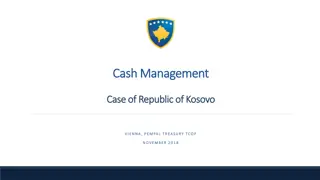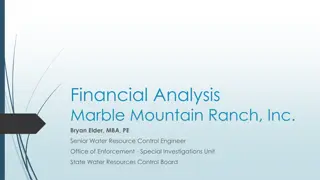Cash Flow Estimation and Risk Analysis Overview
This content delves into the principles of cash flow estimation and risk analysis in project evaluation. It covers learning objectives, incremental cash flows, treatment of financing costs, sunk costs, opportunity costs, and externalities in financial decision-making. Understanding these concepts is crucial for accurate project valuation and investment decisions.
Download Presentation

Please find below an Image/Link to download the presentation.
The content on the website is provided AS IS for your information and personal use only. It may not be sold, licensed, or shared on other websites without obtaining consent from the author. Download presentation by click this link. If you encounter any issues during the download, it is possible that the publisher has removed the file from their server.
E N D
Presentation Transcript
Cash Flow Estimation and Risk Analysis By Dr. Yi Zhang 1
Learning Objectives You should understand relevant cash flows in evaluating projects. You should be able to estimate the following cash flows: Cash flow from operations Cash flow from investments in working capitals Cash flow from salvage sales You should be able to understand risk in capital budgeting 2
Incremental Cash Flow Project s incremental cash flow: Incremental Cash Flow cash flow with project cash flow without project - = Ask yourself this question: Would the cash flow still exist if the project does not exist? If yes, do not include it in your analysis. If no, include it. 3
Treatment of Financing Costs Should you subtract interest expense or dividends when calculating CF? NO. We discount project cash flows with a cost of capital that is the rate of return required by all investors (not just debtholders or stockholders), so we should discount the total amount of cash flow available to all investors. They are part of the costs of capital. If we subtracted them from cash flows, we would be double counting capital costs. 4
Sunk Costs A sunk cost is an outlay that has already occurred or has been committed. Suppose $100,000 had been spent last year to improve the production line site. Should this cost be included in the analysis? NO. This is a sunk cost and not an incremental cost. 5
Opportunity Costs Suppose the plant space could be leased out for $25,000 a year. Would this affect the analysis? Yes. Accepting the project means we will not receive the $25,000. This is an opportunity cost and it should be charged to the project. A.T. opportunity cost = $25,000 (1 - T) = $15,000 annual cost. 6
Externalities If the new product line would decrease sales of the firm s other products by $50,000 per year, would this affect the analysis? Yes. The effects on the other projects CFs are externalities . Net CF loss per year on other lines would be a cost to this project. Externalities will be positive if new projects are complements to existing assets, negative if substitutes. 7
Proposed Project $200,000 cost + $10,000 shipping + $30,000 installation. Economic life = 4 years. Salvage value = $25,000. MACRS 3-year class. Annual unit sales = 1,250. Unit sales price = $200. Unit costs = $100. Net operating working capital (NOWC) = 12% of sales. Tax rate = 40%. Project cost of capital = 10%. 8
Annual Sales and Costs Year 1 Year 2 Year 3 Year 4 Units 1250 1250 1250 1250 Unit Price $200 $206 $212.18 $218.55 Unit Cost Sales $100 $103 $106.09 $109.27 $250,000 $257,500 $265,225 $273,188 Costs $125,000 $128,750 $132,613 $136,588 9
Depreciation Basis=$240,000 (cost+shipping+installation) Straight line depreciation Annual depreciation: $240,000/4=$60,000 MACRS (Modified Accelerated Cost Recovery System) Year % X (Initial Basis) = Depr. 1 0.33 $240 $79.2 2 0.45 108.0 3 0.15 36.0 4 0.07 16.8 10
Why is it important to include inflation when estimating cash flows? Nominal r > real r. The cost of capital, r, includes a premium for inflation. Nominal CF > real CF. This is because nominal cash flows incorporate inflation. If you discount real CF with the higher nominal r, then your NPV estimate is too low. Nominal CF should be discounted with nominal r, and real CF should be discounted with real r. It is more realistic to find the nominal CF (i.e., increase cash flow estimates with inflation) than it is to reduce the nominal r to a real r. 11
Operating Cash Flows (Years 1-4) Year 1 $250,000 $125,000 $79,200 $45,800 $18,320 $27,480 $79,200 $106,680 Year 2 $257,500 $128,750 $108,000 $20,750 $8,300 $12,450 $108,000 $120,450 Year 3 $265,225 $132,613 $36,000 $96,612 $38,645 $57,967 $36,000 $93,967 Year 4 $273,188 $136,588 $16,800 $119,800 $47,920 $71,880 $16,800 $88,680 Sales Costs Depr. EBIT Taxes (40%) NOPAT + Depr. Net Op. CF 12
Cash Flows due to Investments in Net Operating Working Capital (NOWC) CF Due to Investment in NOWC -$30,000 -$900 -$927 -$956 $32,783 NOWC Sales (% of sales) $30,000 $30,900 $31,827 $32,783 Year 0 Year 1 Year 2 Year 3 Year 4 $250,000 $257,500 $265,225 $273,188 $0 13
Salvage Cash Flow at t = 4 (000s) Salvage Value Book Value Gain or loss Tax on SV Net Terminal CF $25 0 $25 10 $15 Taxes are based on difference between sales price and book value. Book value = Original depreciation basis - Accumulated depreciation amount. Cash flow from sale = Sale proceeds- taxes paid. 14
Example: If Sold After 3 Years for $25 ($ thousands) Original basis = $240. After 3 years, book value = $16.8 remaining. Sales price = $25. Gain or loss = $25 - $16.8 = $8.2. Tax on sale = 0.4($8.2) = $3.28. Cash flow = $25 - $3.28 = $21.72. 15
Example: If Sold After 3 Years for $10 ($ thousands) Original basis = $240. After 3 years, book value = $16.8 remaining. Sales price = $10. Gain or loss = $10 - $16.8 = -$6.8. Tax on sale = 0.4(-$6.8) = -$2.72. Cash flow = $10 (-$2.72) = $12.72. Sale at a loss provides tax credit, so cash flow is larger than sales price! 16
Net Cash Flows for Years 1-4 Year 0 Year 1 Year 2 Year 3 Year 4 Init. Cost -$240,000 0 0 0 0 Op. CF 0 $106,680 $120,450 $93,967 $88,680 NOWC CF -$30,000 -$900 -$927 -$956 $32,783 Salvage CF 0 0 0 0 $15,000 Net CF -$270,000 $105,780 $119,523 $93,011 $136,463 17
Project Net CFs on a Time Line 0 1 2 3 4 (270,000) 105,780 119,523 93,011 136,463 NPV = $88,030. IRR = 23.9%. Payback = 2.5 years. 18
What does risk mean in capital budgeting? Uncertainty about a project s future profitability. Measured by NPV, IRR, beta. Will taking on the project increase the firm s and stockholders risk? Risk analysis in capital budgeting is usually based on subjective judgments, not historical data 19
What three types of risk are relevant in capital budgeting? Stand-alone risk Corporate risk Market (or beta) risk 20
Stand-Alone Risk The project s risk if it were the firm s only asset and there were no shareholders. Ignores both firm and shareholder diversification. Measured by the or CV of NPV, IRR. 21
Probability Density Flatter distribution, larger , larger stand-alone risk. NPV 0 E(NPV) 22
Corporate Risk Reflects the project s effect on corporate earnings stability. Considers firm s other assets (diversification within firm). Depends on project s , and its correlation, , with returns on firm s other assets. Measured by the project s corporate beta. 23
Project X is negatively correlated to firms other assets, so has big diversification benefits. If r = 1.0, no diversification benefits. If r < 1.0, some diversification benefits. Profitability Project X Total Firm Rest of Firm 0 Years 24
Market Risk Reflects the project s effect on a well- diversified stock portfolio. Takes account of stockholders other assets. Depends on project s and correlation with the stock market. Measured by the project s market beta. 25
How is each type of risk used? Market risk is theoretically best in most situations. However, creditors, customers, suppliers, and employees are more affected by corporate risk. Therefore, corporate risk is also relevant. Stand-alone risk is easiest to measure, more intuitive. Core projects are highly correlated with other assets, so stand-alone risk generally reflects corporate risk. If the project is highly correlated with the economy, stand-alone risk also reflects market risk. 26
What is sensitivity analysis? Shows how changes in a variable such as unit sales affect NPV or IRR. Answers what if questions, e.g. What if sales decline by 30%? Each variable is fixed except one. Change this one variable to see the effect on NPV or IRR. 27
Sensitivity Graph Unit Sales NPV (000s) Salvage 88 r -30 -20 -10 Base 10 20 30 (%) 28
Results of Sensitivity Analysis Steeper sensitivity lines show greater risk. Small changes result in large declines in NPV. Unit sales line is steeper than salvage value or r, so for this project, should worry most about accuracy of sales forecast. 29
Pros and Cons of sensitivity analysis Pros Gives some idea of stand-alone risk. Identifies dangerous variables. Gives some breakeven information. Cons Does not reflect diversification. Says nothing about the likelihood of change in a variable, i.e. a steep sales line is not a problem if sales won t fall. Ignores relationships among variables. 30
What is scenario analysis? Examines several possible situations, usually worst case, most likely case, and best case. Provides a range of possible outcomes. 31
Best scenario: 1,600 units @ $240 Worst scenario: 900 units @ $160 Scenario Best Base Worst Probability NPV(000) $279 0.25 0.50 .025 88 -49 E(NPV) = $101.5 (NPV) = 116.6 CV(NPV) = (NPV)/E(NPV) = 1.15 32
Are there any problems with scenario analysis? Only considers a few possible out- comes. Assumes that inputs are perfectly correlated--all bad values occur together and all good values occur together. Focuses on stand-alone risk, although subjective adjustments can be made. 33
What is a simulation analysis? A computerized version of scenario analysis which uses continuous probability distributions. Computer selects values for each variable based on given probability distributions. NPV and IRR are calculated. Process is repeated many times (1,000 or more). End result: Probability distribution of NPV and IRR based on sample of simulated values. Generally shown graphically. 34
How to decide the project risk? Sensitivity, scenario, and simulation analyses do not provide a decision rule. They do not indicate whether a project s expected return is sufficient to compensate for its risk. Sensitivity, scenario, and simulation analyses all ignore diversification. Thus they measure only stand- alone risk, which may not be the most relevant risk in capital budgeting. A numerical analysis may not capture all of the risk factors inherent in the project, so manager use subjective judgments to adjust the risk. 35























